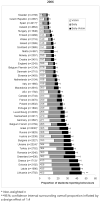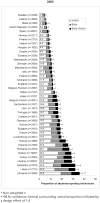A cross-national profile of bullying and victimization among adolescents in 40 countries
- PMID: 19623475
- PMCID: PMC2747624
- DOI: 10.1007/s00038-009-5413-9
A cross-national profile of bullying and victimization among adolescents in 40 countries
Abstract
Objectives: (1) To compare the prevalence of bullying and victimization among boys and girls and by age in 40 countries. (2) In 6 countries, to compare rates of direct physical, direct verbal, and indirect bullying by gender, age, and country.
Methods: Cross-sectional self-report surveys including items on bullying and being bullied were obtained from nationally representative samples of 11, 13 and 15 year old school children in 40 countries, N = 202,056. Six countries (N = 29,127 students) included questions about specific types of bullying (e. g., direct physical, direct verbal, indirect).
Results: Exposure to bullying varied across countries, with estimates ranging from 8.6% to 45.2% among boys, and from 4.8% to 35.8% among girls. Adolescents in Baltic countries reported higher rates of bullying and victimization, whereas northern European countries reported the lowest prevalence. Boys reported higher rates of bullying in all countries. Rates of victimization were higher for girls in 29 of 40 countries. Rates of victimization decreased by age in 30 of 40 (boys) and 25 of 39 (girls) countries.
Conclusion: There are lessons to be learned from the current research conducted in countries where the prevalence is low that could be adapted for use in countries with higher prevalence.
Figures
References
-
- Nansel TR, Overpeck MD, Haynie DL, Ruan J, Scheidt PC. Relationships between bullying and violence among US youth. Arch Pediatr Adolesc Med. 2003;157:348–53. - PubMed
-
- Craig WM, Pepler DJ. Identifying and targeting risk for involvement in bullying and victimization. Can J Psychiatry. 2003;48:577–82. - PubMed
-
- Due P, Holstein PE, Lynch J, et al. Health Behavior in School-Aged Children. Bullying Working Group. Bullying and symptoms among school-aged children: international comparative cross sectional study in 28 countries. Eur J Public Health. 2005;15:128–32. - PubMed
-
- Volk A, Craig WM, Boyce W, King M. Perceptions of parents, mental health, and school amongst Canadian adolescents from the provinces and the northern territories. Can J School Psychol. 2006;21:33–46.
Publication types
MeSH terms
Grants and funding
LinkOut - more resources
Full Text Sources
Medical



